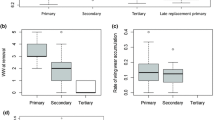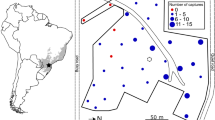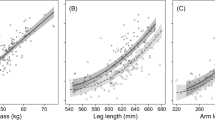Abstract
The mechanisms through which dominance is inherited within social groups vary from direct interactions such as fighting to non-confrontational conventions. Liostenogaster flavolineata is a primitively eusocial hover wasp in which one female, the ‘dominant’, is the only reproductive upon the nest. The remaining females, although capable of reproduction, behave as helpers. In this study, we investigate the rules by which helpers inherit dominance. We removed successive dominants from 56 nests and recorded accession on un-manipulated nests. The results showed that L. flavolineata has a strict age-based inheritance queue: new dominants are the oldest female in their groups 87% of the time. Thirteen cases of queue-jumping were found in which young individuals were able to supplant older nestmates and inherit dominance precociously. Queue jumpers did not differ from other wasps in terms of relatedness to other group members or body size. Individuals that had previously worked less hard than other females of equivalent rank were significantly more likely to later jump the queue. Queue-jumping may represent a cheating strategy or could indicate that the rule for inheriting dominance is not based purely on relative age. We also discuss possible reasons why age-based queuing has evolved and its potential to promote the evolution of helping behaviour.


Similar content being viewed by others
References
Appleby MC (1983) Competition in a red deer stag social group: rank, age and relatedness of opponents. Anim Behav 31:913–918
Buston PM (2004) Territory inheritance in clownfish anemonefish. Proc R Soc Lond B 271(Suppl):S252–S254
Cant MA, Field J (2001) Helping effort and future fitness in cooperative animal societies. Proc R Soc Lond B 268:1959–1964
Carpenter JM (2003) On “molecular phylogeny of Vespidae (Hymenoptera) and the evolution of sociality in wasps”. Am Mus Novitat 3389:1–20
Crawley MJ (2005) Statistics: an introduction using R. Wiley, Chichester, West Sussex, England
Dunn PO, Cockburn A, Mulder RA (1995) Fairy-wren helpers often care for young to which they are unrelated. Proc R Soc Lond B 259:339–343
Field J, Foster W (1999) Helping behaviour in facultatively eusocial hover wasps: an experimental test of the subfertility hypothesis. Anim Behav 57:633–636
Field J, Foster W, Shreeves G, Sumner S (1998) Ecological constraints on independent nesting in facultatively eusocial hover wasps. Proc R Soc Lond B 265:973–977
Field J, Shreeves G, Sumner S (1999) Group size, queuing and helping decisions in facultatively eusocial hover wasps. Behav Ecol Sociobiol 45:378–385
Field J, Shreeves G, Sumner S, Casiraghi M (2000) Insurance-based advantage to helpers in a tropical hover wasp. Nature 404:869–871
Field J, Cronin A, Bridge C (2006) Future fitness and helping in social queues. Nature 441:214–217
Goodnight KF, Queller DC (1999) Computer software for performing likelihood tests of pedigree relationship using genetic markers. Mol Ecol 8:1231–1234
Johnstone RA, Grafen A (1993) Dishonesty and the handicap principle. Anim Behav 46:759–764
Kokko H, Johnstone RA (1999) Social queuing in animal societies: a dynamic model of reproductive skew. Proc R Soc Lond B 266:571–578
Lorenzi MC, Sledge MF, Laiolo P, Sturlini E, Turillazzi S (2004) Cuticular hydrocarbon dynamics in young adult Polistes dominulus (Hymenoptera: Vespidae) and the role of linear hydrocarbons in nestmate recognition systems. J Insect Physiol 50:935–941
Panek LM, George GJ, Espelie KE (2001) The effect of a wasp’s age on its cuticular hydrocarbon profile and its tolerance by nestmate and non-nestmate conspecifics (Polistes fuscatus, Hymenoptera: Vespidae). Ethology 107:55–63
Parsons J, Baptista LF (1980) Crown colouration and dominance in the white-crowned sparrow. Auk 97:807–815
Queller DC, Goodnight KF (1989) Estimating relatedness using genetic markers. Evolution 43:258–275
Queller DC, Zacchi F, Cervo R, Turillazzi S, Henshaw MT, Santorelli LA, Strassmann JE (2000) Unrelated helpers in a social insect. Nature 405:784–787
Ragsdale JE (1999) Reproductive skew theory extended: the effect of resource inheritance on social organization. Evol Ecol Res 1:859–874
Rohwer S (1985) Dyed birds achieve higher social status than controls in Harris’ sparrows. Anim Behav 33:1325–1331
Samuel CT (1987) Factors affecting colony size in the stenogastrine wasp Liostenogaster flavolineata. Ph.D. dissertation, University of Malaya
Schmitz J, Moritz RFA (1998) Molecular phylogeny of Vespidae (Hymenoptera) and the evolution of sociality in wasps. Mol Phylogenet Evol 9:188–192
Seppä P, Queller DC, Strassmann JE (2002) Reproduction in foundress associations of the social wasp, Polistes carolina: conventions, competition, and skew. Behav Ecol 13:531–542
Shreeves G, Field J (2002) Group size and direct fitness in social queues. Am Nat 159:81–95
Stacey PB, Koenig WD (1990) Cooperative breeding in birds: long term studies of ecology and behaviour. Cambridge University Press, Cambridge
Strassmann JE, Meyer DC (1983) Gerontocracy in the social wasp, Polistes exclamans. Anim Behav 31:431–438
Strassmann JE, Solis CR, Peters JM, Queller DC (1996) Strategies for finding and using highly polymorphic DNA microsatellite loci for studies of genetic relatedness and pedigrees. In: Ferraris JD, Palumbi SR (eds) Molecular zoology: advances, strategies, and protocols. Wiley-Liss, New York, pp 163–180
Sumner S, Field J (2001) Highly polymorphic microsatellite loci in the facultatively eusocial hover wasp, Liostenogaster flavolineata and cross-species amplification. Mol Ecol Notes 1:229
Sumner S, Casiraghi M, Foster W, Field J (2002) High reproductive skew in tropical hover wasps. Proc R Soc Lond B 269:179–186
The R project for statistical computing (2005) http://www.r-project.org/
Tibbetts EA (2002) Visual signals of individual identity in the wasp Polistes fuscatus. Proc R Soc Lond B 269:1423–1428
Tibbetts EA, Dale J (2004) A socially enforced signal of quality in a paper wasp. Nature 432:218–222
Tsuji K, Tsuji N (2005) Why is dominance hierarchy age-related in social insects? The relative longevity hypothesis. Behav Ecol Sociobiol 58:517–526
Veiberg V, Loe LE, Mysterud A, Langvatn R, Stenseth NC (2004) Social rank, feeding and winter weight loss in red deer: any evidence of interference competition? Oecologia 138:135–142
Wiley RH, Rabenold KN (1984) The evolution of cooperative breeding by delayed reciprocity and queuing for favourable social positions. Evolution 38:609–621
Acknowledgements
We thank E. Almond, S. Brace, G. Shreeves and D. Stevens for the help with the fieldwork. Thanks also go to E. Hornett for the help with genotyping and K. Durai, H. Rosli and A. Sofian for their hospitality in Malaysia. A. Cronin kindly gave us access to the 2003 datasets. We thank E. Almond, E. Lucas, L. Zanette and A. Pomiankowski for the useful discussion and the Natural Environment Research Council for funding. The experiments conducted in this study comply with the current laws of the country in which they were performed.
Author information
Authors and Affiliations
Corresponding author
Additional information
Communicated by K. Ross
Rights and permissions
About this article
Cite this article
Bridge, C., Field, J. Queuing for dominance: gerontocracy and queue-jumping in the hover wasp Liostenogaster flavolineata . Behav Ecol Sociobiol 61, 1253–1259 (2007). https://doi.org/10.1007/s00265-007-0355-9
Received:
Revised:
Accepted:
Published:
Issue Date:
DOI: https://doi.org/10.1007/s00265-007-0355-9




